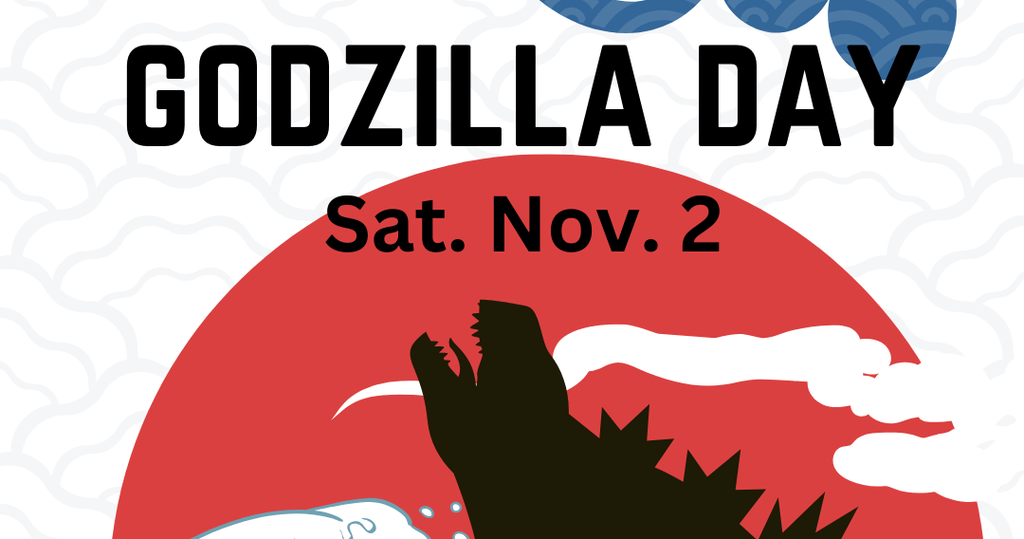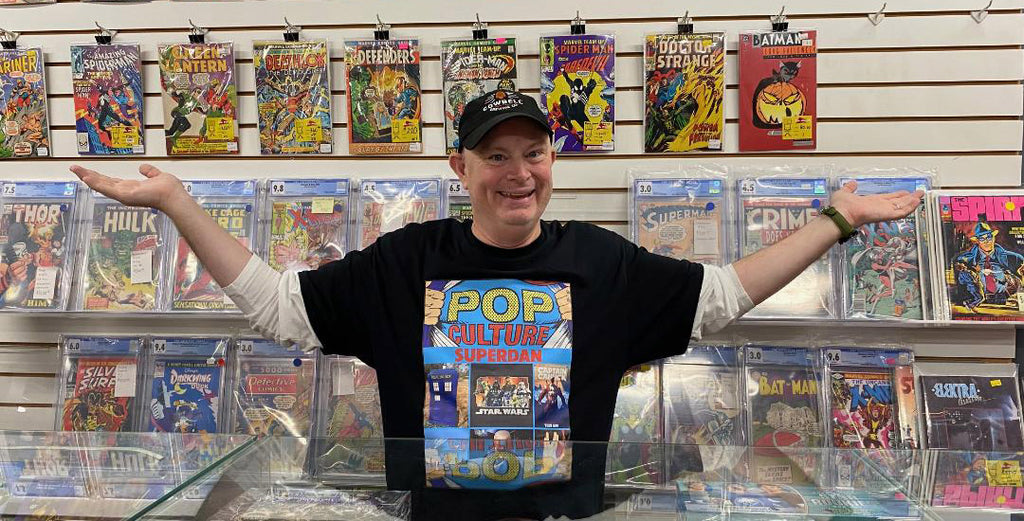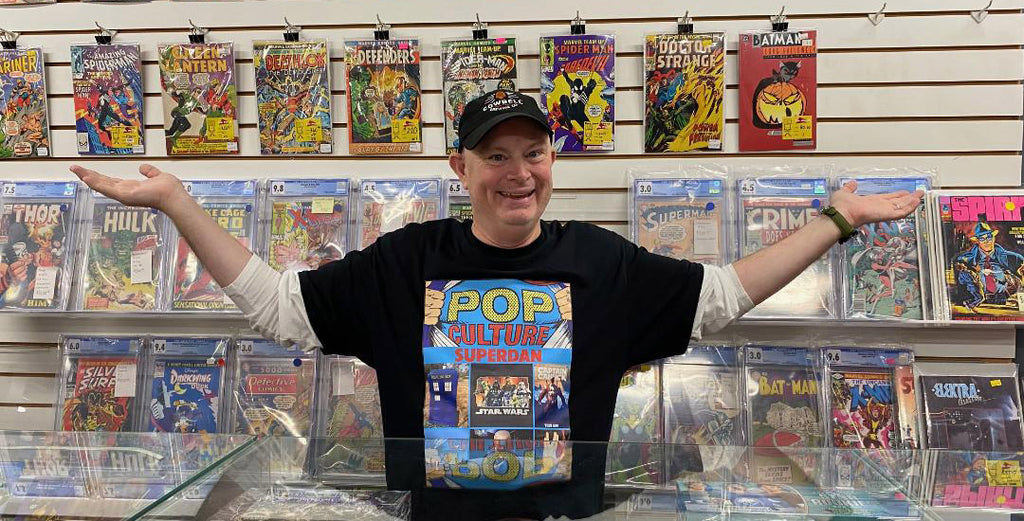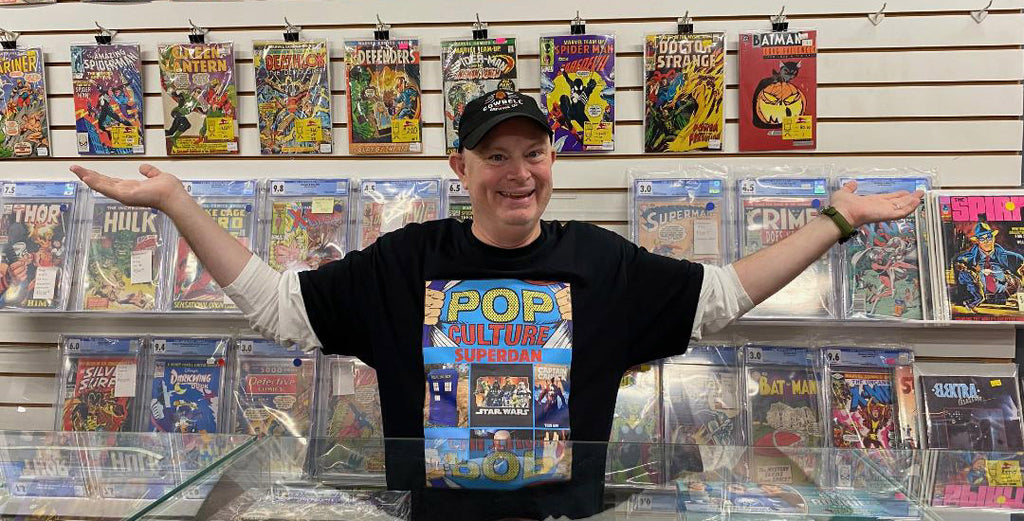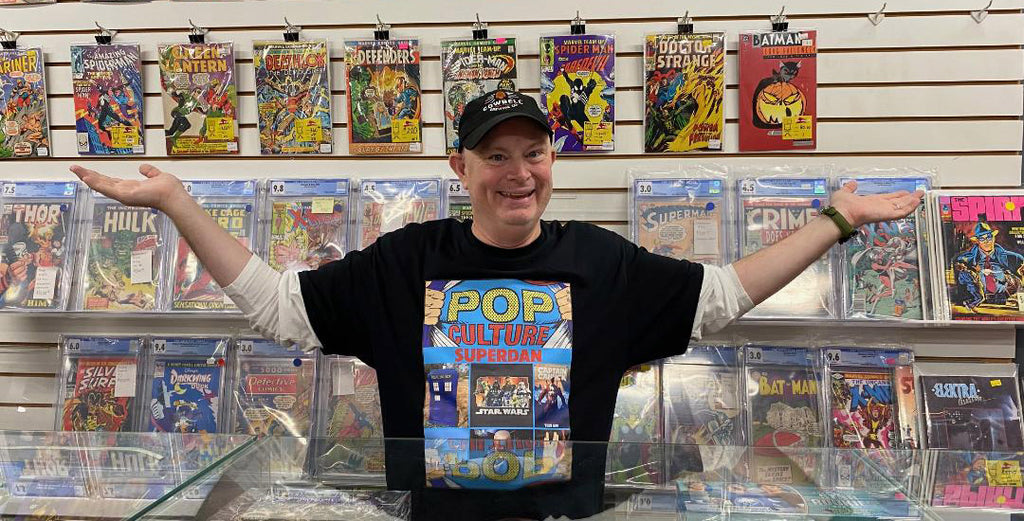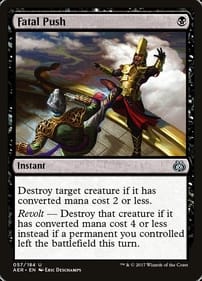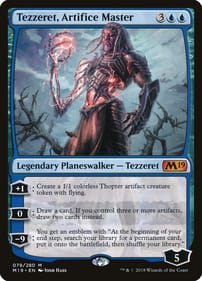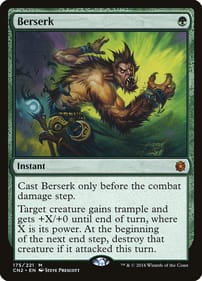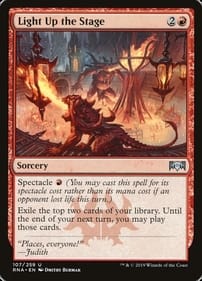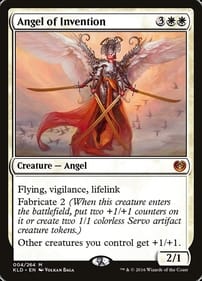Celebrate 70 Years of Godzilla with Us (Godzilla Day London Ontario) Nov 2
Join the fun at this monstrous 70th anniversary event!We are excited to have a human size Godzilla cosplay guest on site. Tristan Domay is one of Canada's premiere Godzilla cosplayers. He has been building and performing as monstrous characters for over 15 years. An award winning artist and filmmaker, he is a longtime contributor to the kaiju and tokusatsu fandoms. Working annually with Dojo Studios since 2010, he has helped to bring Western Godzilla fans unique experiences usually unseen outside of Japan, including live stage shows, special effects demonstrations, as well as academic panels on costuming and the history of the kaiju genre. In his spare time he moonlights as a late night horror host and lover of all things macabre.Don’t miss out! We will be open Saturday November 2 from 10 am till 7 pm.Come on by L.A. Mood at 100 Kellogg Lane, suite 5, London.
Scary Halloween Graphic Novels
By Dan BrownIn time for Halloween, here’s a rundown of graphic novels that range from unsettling to creepy to scary to horrifying. Read them at your peril, boys and girls!Vision: The Complete Collection: Imagine you live in suburbia and your new neighbours turn out to be emotionless androids. Literally. This Tom King-written story ends with the Vision taking on pretty much the entire Marvel universe.Monsters Volume 1 and 2: These omnibuses, dubbed “monsterbuses,” collect classic tales by Jack Kirby from the 1950s and 1960s, when evil creatures came with names like Fin Fang Foom. Find out what the world was like before superheroes! Before Marvel was even Marvel!The Simon and Kirby Library: Horror!: See some utterly creep characters the King came up with before he switched to inventing the Marvel universe pretty much on his own. In addition to EC’s many gruesome titles, this is the kind of comic that got denounced by U.S. politicians for causing juvenile delinquency!Any EC collection: From the publisher that brought you the Crypt Keeper! It doesn’t matter which EC horror anthology you read (they have titles like Tales From the Crypt and Crypt of Terror), they are all great examples of EC’s thoughtful suspense and horror!Monsters: Originally envisioned as a story about the Hulk, this thick tome from Conan the Barbarian artist Barry Windsor Smith is as gorgeous as it is horrifying! A military experiment goes wrong and unsuspecting civilians pay the price! Nicely marries horror with a touch of magic realism.Something is Killing the Children Book One: You can file this series under the heading of “the title is the premise.” Something evil has been leaving a trail of lifeless tots in its wake in the sleepy small town of Archer’s Peak. Will a heroine rise to stop the slaughter of innocents? Written by James Tynion IV.Wild’s End: Your basic alien invasion story set between the wars. The twist: The characters who populate the British countryside are anthropomorphized animals. The alien invaders look kind of like Victorian-era street lamps and remind me a bit of Triffids. This ain’t no Watership Down!H.P. Lovecraft’s At the Mountains of Madness Volumes 1 and 2: This manga adaptation of Lovecraft’s story about a doomed Antarctic expedition is made even more unworldly by the fact it’s a manga. Japanese creator Gou Tanabe takes his time to recount this encounter between humankind and the previous alien inhabitants of this planet.The Nobody: This Jeff Lemire joint, which made nary a splash when it came out in 2009, asks the question, What if the Invisible Man came to Essex County? Yes, I know Lemire never specifically says the story takes place in Southwestern Ontario, but it’s easy to imagine it does.Snotgirl Volume One: Green Hair Don’t Care: Written by Londoner Bryan Lee O’Malley (yes, he does stuff other than Scott Pilgrim!) this is a psychological drama featuring an influencer named Lottie Person. The fun comes from trying to guess how much of her adventures are really happening and how much of the action is in Lottie’s head. Vampirella Archives Volume One: My favourite version of Vampirella is the one featured in these stories from 1970s Warren Publishing magazines that were drawn by Jose Gonzalez. Giving the character a science-fiction twist – in this continuity, vampires are from the planet Drakulon – infused her stories with that X factor I was looking for as a kid.Ducks: Two Years in the Oil Sands: What does Kate Beaton’s account of her time in the oil patch have to do with Halloween? If you’ve ever wondered how an entirely male society would work, Ducks explores that theme in horrifying detail. Ducks is all the scarier for the fact it really happened. The old standbys: There’s also the Walking Dead for zombie fans, 30 Days of Night for vampire enthusiasts, and Hellboy books like Conqueror Worm for fans of the paranormal.Your suggestions: What are YOU reading this spooky season? I want to hear it in the comment box below!Dan Brown has covered pop culture for more than 31 years as a journalist and also moderates L.A. Mood’s monthly graphic-novel group.
Sentinels is Dark and Looks to Get Darker
By Dan BrownSentinels No. 1 has an intriguing premise, but man is it dark. With such a grim start, I’m not sure where the new series will go from here. Can it get any more dystopian?Billed as Marvel’s token “bad-guy book” among the company’s 18 (by my count) X-titles, it features a cast of military types who have been implanted with sentinel technology. They are machine/human hybrids whose goal is to forcefully corral mutants, then bring them to prison.In keeping with the dystopian theme, the prison is housed in the basement of Professor Charles Xavier’s former school for gifted children i.e. mutants. But where Xavier’s dream was to find a way for mutants and humans to co-exist, the sentinels are programmed – and kept in line with mood-regulating drugs – to use violence to bring them in. It’s a world turned upside-down.This all takes place in Marvel’s post-Krakoa universe. Last time I checked in with the X-Men, they were living pretty much as immortal gods on the sentient sanctuary island. I wondered what Marvel was going to do with its mutant characters once that storyline ran its course, and now readers are beginning to find out. (Marvel has said it will be concentrating more on solo titles featuring the likes of Wolverine and Storm as the mutants reintegrate into society.)Not to be trusted with their genocidal instincts, the giant sentinel robots themselves have been powered down in favour of these cyborgs. The danger for the bad guys, who have code names like Lockstep, Drumfire and Sawtooth, is that the cybernetic implants have a tendency to take over their minds and bodies completely, a process called “full grafting” which destroys their remaining humanity.The issue is a finely crafted comic, with art by Justin Mason and writing by Alex Parknadel, creators whose work is new to me. Let’s just say the result is not something Jack Kirby and Stan Lee would ever have dreamed up.There’s also friction between the civilian who pulls the team’s strings, the mutant Lawrence Trask, and the military commander on the ground. It’s reminiscent of what happens in pro sports when a coach can’t get along with his or her general manager.The issue starts with the team dropping into an isolated Russian village to take the homicidal mutant “Omega Red” into custody. Naturally, things don’t go according to plan.There are dark hints as the issue unfolds about how the incarcerated mutants are being treated, which seems to be even worse than the sentinels themselves. They operate in a world in which there are no clear moral lines between human and mutant or organic and mechanical.Some of the team members rationalize their missions by stressing that all they are is hunters – what is done to the captive mutants once they have been put into a cell is none of their business.We also get a glimpse of Trask’s motivation when he recalls the story of two neighbouring villages in thirteenth-century England during a wolf cull. Once the animals victimizing the two communities have been dispatched, he explains, the residents turned on each other.Trask reasons that his role in backing the sentinels is to keep humanity and mutantkind in a kind of equilibrium or stasis so they don’t massacre the other. The sentinels are the “necessary monsters” who keep a “fragile peace” between humans and homo superior. Speaking of Magneto, he doesn’t appear in this issue, but his former ally the Blob does. There’s a different archvillain from the X-Men’s past who graces the story’s final page. You’ll never guess who it is, but I didn’t see his appearance coming. Dan Brown has covered pop culture for more than 32 years as a journalist and also moderates L.A. Mood’s monthly graphic-novel group.
Colin Kaepernick Not Making Friends with AI Comics Venture
By Dan BrownYou may know Colin Kaepernick as the NFL quarterback who struck a blow for civil rights.But now the former football player wants to revolutionize the comic industry. And that’s not a good thing.Sports fans are familiar with Kaepernick because eight years ago he took a knee during the American national anthem at a San Francisco 49ers game to protest police brutality and racial injustice. More kneeling ensued, as well as much controversy.He came to the attention of comics fans this summer when he announced the founding of his artificial-intelligence company, Lumi, which aims to “free creators and democratize storytelling.”Sounds great, right? The unsaid part is that he wants to replace work done by comic artists and writers with images and words generated by an AI. This has not endeared him to the comics community.It probably didn’t help his cause when he made his intentions known in a press release that sounds like it was generated by a robot.With $4 million in funding behind it, Lumi is a “groundbreaking platform that empowers creators by providing them with the tools needed to independently create, publish and merchandise their stories both digitally and physically.”How will this be done? By putting the human creators who would have otherwise created these stories out of work.I haven’t done a survey of people in the field, but I’m not currently aware of any comic creators who were looking for this kind of shortcut. “By leveraging advanced AI tools, Lumi enhances the creative process, allowing creators to focus on bringing their stories to life, while the platform handles all of the logistics,” the statement adds. The company boasts this will make every creator into a Walt Disney. But whatever you think of Disney’s labour practices, he at least employed actual human animators.It seems Kaepernick has himself run up against “gatekeeping” in the comic industry.“Currently, a few large corporations dominate the narrative landscape, limiting the diversity of stories told. Lumi aims to open the funnel, enabling anyone to access storytelling superpowers, ultimately fostering a more inclusive and equitable world.”The reality, of course, is that the internet has made the barrier to entry ridiculously low. For better or worse, all you need to be a comic creator in 2024 is a computer and an idea. And anyone who has been paying attention to the graphic-novel market over the last dozen years also knows there are now graphic novels and comics for almost every taste. Besides, AI art and writing is just . . . weird.Granted, I haven’t seen the finished product of a comic produced with the help of Lumi. Who knows, it might be better at drawing than all the other AIs out there.But even if it’s the best AI art ever invented, it still can’t match the creativity of the human mind. You could argue that it’s the flaws, the human element, that make comics attractive to human readers in the first place. Someone like John Porcellino is not a master illustrator, but his simple images are the perfect vehicle for making the emotional points he wants to make. The results are comics that verge on the poetic.Nor am I against the use of technology in the making of comics. If it makes drawing or writing easier for a human, go for it, but the comic creators I love don’t give up those functions entirely to a machine.“Creators today face significant challenges, including exploitation and lack of independence,” the statement claims. “Lumi addresses these issues by providing an end-to-end solution for storytelling leading to more financial stability, creative control, and ownership of their work.”Yup, sounds like the comic biz to me!Oh, and at the risk of belabouring the point – there was and will only ever be one Walt Disney!Dan Brown has covered pop culture for more than 32 years as a journalist and also moderates L.A. Mood’s monthly graphic-novel group.
The Marvel Universe: An appreciation
By Dan Brown Did you ever have one of those posters showing all the Marvel superhero characters gathered together in one place? Over the decades, successive generations of Marvel artists have depicted that crowded scene – row after row of colourful do-gooders, a cast of literally thousands, standing at the ready to fight evil.. Whether this heroes’ gallery was drawn by Jack Kirby, John Byrne or Michael Golden or someone else, my jaw hits the floor every time I see it. I am in awe of the creative energy it must have required to come up with backstories and costumes for all of them. So what I want to do this week is take a moment to praise the folks at Marvel for doing such a good job of churning out one interesting character after another since 1939. This will come as no surprise to regular readers who know I was raised on Marvel Comics in the 1970s. (And don’t worry, DC fans, I’ll do a tribute to that company’s stable when I figure out the right way to do it.) When it comes to being prolific, no other comic publisher has the track record Marvel does. What a riot of invention! What a unique assemblage of talent! What a big bang of creativity that set and kept the Marvel Universe in motion! The Marvel Universe is what results when the right talented people get together and are allowed the freedom to let their minds wander. It’s an example of what no less an authority than Willy Wonka calls “pure imagination.” Jack Kirby and Stan Lee – who launched such comics as the Avengers, the Fantastic Four, the Incredible Hulk and the Uncanny X-Men – were undeniably the creators among creators at Marvel. I don’t want to get too much into the weeds on the question of which man possessed the real vision, so let’s just state for our purposes here today that Kirby and Lee combined are among the greatest and most prolific American originators of characters, in the same league as Walt Disney, Jim Henson, Dr. Seuss and Mark Twain. It’s true the different creative teams at Marvel were motivated by economic necessity. They never met a trend they didn’t try to plunder, like the disco craze. No sooner, it seemed, had Studio 54 opened than Marvel came up with the mutant Dazzler – who has all the powers of a disco ball! When kung fu movies likewise hit it big, Marvel answered with Shang-Chi and Iron Fist. Sometimes the plundering was done for the right reasons, as when characters like Black Panther and Power Man were devised to give black readers heroes of their own. Although some fans have by now grown weary of the offerings from Marvel’s movie division, the studio hasn’t even begun to scratch the surface of the vast library of characters it owns. No one would call the comic-book Agatha Harkness a major Marvel character, but there’s currently an entire series streaming right now devoted to her solo adventures. A series about Wonder Man – another B-list character – is set to debut next year. As someone who appreciates and values imagination, I can’t help but be deeply impressed by how productive Marvel has been over the decades, creating a surplus of diverse characters who have now become recognized around the world. And yes, the chumminess of the Marvel Bullpen was likely an illusion created by Lee to help infuse the Marvel brand with an air of fun, but at the end of the day we are still left with what all of those artists, writers, colourists, letterers and editors wrought: An entirely original group of compelling heroes. There’s literally a character for everyone. I stand in awe. Dan Brown has covered pop culture for more than 31 years as a journalist and also moderates L.A. Mood’s monthly graphic-novel group.
Maurice Vellekoop’s Coming-of-Age Story Mirrors That of Toronto
By Dan BrownI’m So Glad We Had This Time Together is the story of one man, but also a city.The graphic memoir, released earlier this year, describes how future visual artist Maurice Vellekoop grew up closeted in a strict Dutch immigrant family in Toronto. The experience haunts him for much of his adult life.As Vellekoop comes of age, so does his hometown; his sexual awakening coincides with Toronto’s arrival on the world scene.These dual narratives make for compelling reading. It doesn’t happen often that I’m so engrossed in a graphic novel I lose track of time, but that’s the kind of hold the book had on me.It’s one of the few comics of which I can say: I wish it went on longer.As a young boy, Vellekoop’s imagination is fired when his father takes him to see Walt Disney’s Fantasia. It was “an experience that more or less set the course for the rest of my life,” he explains.Vellekoop’s drawing style reminds me of that of Seth, arguably the father of Canada’s autobiographical school of graphic storytelling. Vellekoop uses devices like giving his inner child and his inner demon actual shape and form; they flit about his head as he struggles with contradictory emotions.After years of therapy, Vellekoop absorbs both figures into himself, indicating he is overcoming the damage done by his religious parents.Music, which also looms large in Vellekoop’s life, is portrayed as lyrics dancing across several panels in the book. It’s these kinds of visual innovations that kept this reader engaged for almost 500 pages. The artist/writer devotes a big chunk of that to his childhood, and in a couple sections I wish he had taken extra time to develop aspects of his life as an adult in a more fulsome way.The parallel story here is that of Canada’s largest city, and its queer community.In at least a couple passages, I spotted figures from Toronto gay history like the late Gerald Hannon, who was an instructor of mine when I attended Ryerson University’s journalism school in the 1990s. Partway through his account, Vellekoop makes his home in a cottage on the Toronto Islands. On lonely Saturday nights, he watches movies on TV hosted by Elwy Yost. There’s a mention early in the book of “gay cancer,” indicating Vellekoop is then living under the shadow of HIV/AIDS – even before it was called that. Later on, he has an inner debate about bringing home a stranger from a bar. “What if he’s Toronto’s own Jeffrey Dahmer?” Vellekoop wonders. As we now know, there was a serial killer targeting queer men in Toronto’s gay village for several years, Bruce McArthur.Vellekoop also recounts being gay-bashed on two occasions. The first of these attacks is all the more shocking and disappointing when Vellekoop’s father declines to come check up on his son, leaving him with deep emotional scars.I’m So Glad We Had This Time Together also has the most compelling depiction of talk therapy I’ve ever read. You might think two people sitting and chatting wouldn’t be great material for a comic book, but with devices like flashbacks and the aforementioned personal avatars it becomes a dynamic scene.In Seth’s work he wields nostalgia like a weapon; over the years, he has used the fictional town of Dominion – his answer to the Marvel Universe – to evoke a Canada that never existed but which we can all remember. In Maurice Vellekoop’s new graphic memoir, he likewise uses specific details to paint a vivid portrait not of Toronto, but of a Toronto of the mind, with all its grime, glory and Gerald Hannons. That’s why it has fast become a classic of the genre.Dan Brown has covered pop culture for more than 31 years as a journalist and also moderates L.A. Mood’s monthly graphic-novel group.


